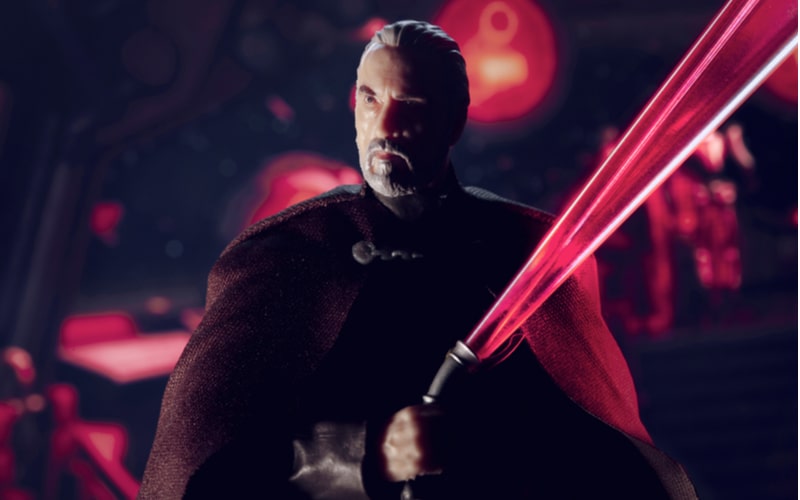Affectionately called “Red Blades,” Inquisitors are force-sensitives who operate under the dark side’s Inquisitorious Program. This organization didn’t come into existence until the tragic events of Order 66.
Which, for those who don’t know, occurred when the clones were manipulated into seeing all Jedi as the enemy. This prompted the Great Jedi Purge, which resulted in the deaths of a whopping 99% of the Jedi Order.
The one percent that survived either went into exile, like Jedi Grand Master Yoda, or worked on rebuilding the Jedi Order, like Luke Skywalker. The main reason being, that exile provided the perfect way for the surviving Jedi to hide from the Sith who wanted them dead.
For Master Yoda exiling served two purposes. Aside from allowing him to hide from the Sith, his alone time allowed him to atone for failing to protect the lives of his comrades, and their home.
Naturally, Count Dooku, the orchestrator of Order 66, thought about all this and created the Inquisitorious Program. Working under the stern hand of Dark Lord Darth Vader, the Inquisitors’ job was to hunt and annihilate the escaped Jedi.
Additionally, they were to find any force-sensitive children and take them back to be trained as Sith. Certainly, to successfully do their job, the inquisitors had to be highly trained.
This begs the question, did they adhere to the Rule of Two?
Keep reading as we answer this question and more throughout this article.
About the Rule of Two
Developed by Sith Lord Darth Bane, the Rule of Two is a principle that governed the way the Sith trained. This rule made it clear that only two Sith Lords could exist at a time.

The pair must begin with a Sith Master who is the embodiment of what the dark side entails and an apprentice whose thirst for power means they would do anything to become a Sith Lord.
This rule is similar to the Jedi philosophy that there could only be one padawan training under a Jedi Master at a time. For both the Jedi and the Sith, this was a good rule, as it allowed the apprentice to have the undivided attention of their master.
However, the creation of the Rule of Two stretched beyond that.
It is said that the Rule of Two was created because Darth Bane wanted the Sith to train and strengthen themselves without the detection of Jedi, as they prepared for their revenge.
In addition to that, Bane did not want the Sith to be like the Kaan’s Brotherhood of Darkness. He deemed them to be weak, so after its destruction, he rebuilt the Sith Order in a way that would ensure they would not fall as the Brotherhood did.
Therefore, he believed this new system would prevent the Sith from failing as they had before.
Do Inquisitors Break the Rule of Two?
It must be remembered that the Inquisitors are not full-blown Sith. They exist within an organization of their own, which is a subsection of the Galactic Empire as a whole.
Therefore, they would not have broken the Rule of Two because they did not adhere to the same rules as the Sith, otherwise known as the Sith Code.

Thus, multiple Inquisitors could have trained under the same person, without breaking the Rule of Two. Which is exactly what they did.
Given that he was the head of this sector, Darth Vader was the man who got the Inquisitors ready for their missions. Now, I know what you may be thinking, wouldn’t this mean that Darth Vader broke the Rule of Two?
No, he didn’t break the rule at all. Let me explain.
As we mentioned before, the Rule of Two involved only two Sith at any given time: a master and an apprentice. Because the Inquisitors are not true Sith, then the Rule of Two’s criteria is not met. By training them, Darth Vader did not infringe on any rules.
Did Any Sith Break the Rule of Two?
Of course, just as with any other rule, the Rule of Two was not immune to rebels. Hence, there were Sith who broke the rule by having multiple trainees.
One such rule-breaking Sith was Darth Sidious, also known as Palpatine.
It’s no surprise that Darth Sidious was the one who broke this rule, as he has always been keen on going against the status quo. After all, he did betray and murder his own master, Darth Plagueis.
Being the rebel that he was, Palpatine had both unofficial and official students. His unofficial students were taught in secret, whereas his official students were known to the rest of the Sith Order.
One might assume that because they were known, the official apprentices were trained in a way that did not violate the Rule of Two. Yet, this is not correct.
Palpatine had three official students, they were Darth Vader, Darth Maul, and Count Dooku. Each of which seemed to have a special part to play in Darth Sidious’ agenda.
Darth Maul, who was trained simultaneously with Count Dooku, was a trigger-happy, power-hungry, self-serving person.

He took the skills that Palpatine taught him and used them to rain down hell on the Jedi. Maul tormented Obi-wan Kenobi in particular until he met his end at Obi-wan’s hands.
Count Dooku was the mastermind behind the corruption of the clones that led to Order 66. Then there is the Chosen One, Anakin Skywalker, who Sidious knew would be a major asset on the dark side.

Therefore, he trained him by himself and manipulated Anakin from the get-go to ensure he became Darth Vader.
Conclusion
The Inquisitors were something of a dark-side hitman mixed with a bounty hunter.
This is because their sole purpose was to hunt down the Jedi who escaped the Purge and get rid of them. As well as to find force-sensitive children and bring them back to the dark side so they can be trained in the ways of the Sith.
The Inquisitors belonged to the organization known as the Inquisitorious Program, which was ruled by Darth Vader.
The Sith usually have a set of rules (the Sith Code) that they must adhere to, but the good thing about the Inquisitors is that those rules did not apply to them.
This includes Darth Bane’s Rule of Two because this rule was specific to the Sith and the Inquisitors were not actual Sith.
Of those whom the Rule of Two was meant for, some of them blatantly disregarded this rule. Namely, Sith Lord Darth Sidious ignored this rule and took on more than the standard one apprentice per master.

